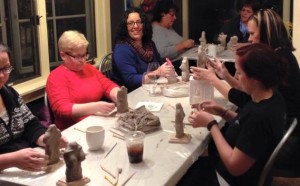Experts say there are a few things we can all do to preserve and even develop brain agility throughout adulthood and into our later years. One key is to incorporate divergent as well as convergent thinking – both the linear and the creative thought processes – into our days.
How do we do this? As it turns out, the medium of sculpture offers a unique set of benefits.
According to neuroscientist and Tedx speaker Eric Kandel, “The tactile system is one set of neural pathways in the brain. The visual system in another. When the two converge, the combined effect can be very powerful.” He goes on to describe how engaging with sculpture brings together memory, intellect and sensory impressions.
Because it is a “both-handed” endeavor, sculpture – more than other art forms such as drawing or painting – engages both sides of the brain. This integration promotes overall cognitive function by mitigating the process of lateralization, or use of specific areas of the brain for different functions, which tends to progress with age.
Dr. Ivan Tirado, an artist who earned his doctorate in instructional design, appreciates sculpture’s connection to a pre-verbal state of human development. “Blending cognitive psychology with art has always been interesting to me. Sculpting, for example, connects us with the first loving touches we received as babies.”
He also points out that making art helps the brain access the state of relaxation so necessary to effective decision-making. “Research shows that tapping into creative flow offers the same neurological benefits as meditation or massage.”
Says one of his students, “When you’re up on your feet, moving around, encouraged to look at things in a new way, it broadens your perspective. It’s not just about art. It teaches you how to pay attention.”
Two years ago Tirado began holding Sculpture Parties to promote social and cognitive wellbeing through the creative process, particularly to encourage acceptance of our imperfections as we grow older by studying the human form. “We’re all a book, writing it as we go. We have to fall in love with all of the changes as they happen.”
As he wrote in his dissertation, art provides experiences that “improve self-efficacy, which is the perception of skills to achieve a goal, by bridging new concepts to known concepts and experiences, focusing on short-term goals, guidance, feedback, and motivation. Commitment to short-term goals leads to accomplishment, which improves self-efficacy, creating a cycle of transformation.” These brief, linear sequences embedded into cyclical feedback loops achieve the combination of divergent and convergent thinking recommended for keeping an individual’s neural connections rapid, plastic and strong.
Tirado’s artwork is published in the books International Contemporary Masters VI (World Wide Art Books, 2012) and Important World Artists (WWAB, 2013). His research is published in the International Journal of Strategic Information Technology and Applications.
LEARN MORE and – if you’re in the New Haven area register for one of his Sculpture Parties!


[…] going on is to read when someone writes about it. I want to share this guest post article with you: Sculpt Your Brain. Enjoy it! Let me know what you think about […]
[…] Another article from the Arts Interstices shows how sculpture is particularly beneficial: https://artsinterstices.com/2015/03/31/sculpture-the-agile-brain/ […]